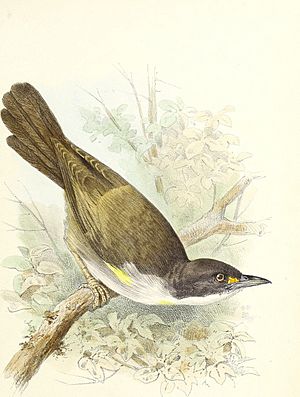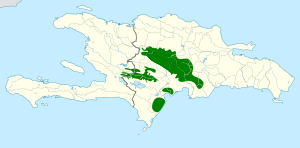Eastern chat-tanager facts for kids
Quick facts for kids Eastern chat-tanager |
|
|---|---|
 |
|
| Conservation status | |
| Scientific classification | |
| Genus: |
Calyptophilus
|
| Species: |
frugivorus
|
 |
|
The eastern chat-tanager (Calyptophilus frugivorus) is a special type of bird. It is considered a Near Threatened species, meaning it could become endangered soon. This bird is a passerine, which is a group of birds that includes most songbirds. It belongs to the family Calyptophilidae.
This unique bird lives only on the island of Hispaniola. Hispaniola is home to two countries: the Dominican Republic and Haiti. The eastern chat-tanager is mostly found in the Dominican Republic. Sadly, it might no longer exist in Haiti.
Contents
What is the Eastern Chat-Tanager Like?
The eastern chat-tanager is about 17 to 19 centimeters (7 to 7.5 inches) long. It weighs around 26 to 39 grams (0.9 to 1.4 ounces). This bird has a long beak and a long tail. Because of its shape, it looks a bit like a mockingbird.
Both male and female eastern chat-tanagers look the same. Adult birds have a dark brown head and a dark grayish-brown face. They have a yellow line near their beak and a yellow ring around their eye. Their upper body is a dark olive-brown color. Their throat and belly are white. The sides and lower belly have a grayish-brown color.
There are different types, or subspecies, of the eastern chat-tanager. One type, C. f. neibae, is smaller and darker. It also has a reddish tail. Another type, C. f. abbotti, is slightly smaller and more grayish-brown.
Where Does the Eastern Chat-Tanager Live?
The eastern chat-tanager lives in the Dominican Republic. One type, C. f. frugivorus, used to live on the Samaná Peninsula. However, this type is now thought to be extinct. It has not been seen since the early 1980s.
The type called C. f. neibae lives in the Sierra de Neiba mountains. These mountains are in the western part of the Dominican Republic. This type might also live in Haiti.
Another type, C. f. abbotti, lived on Gonâve Island, off the coast of Haiti. This type is also believed to be extinct since the early 1980s. But scientists have not explored the island much. So, there is a small chance it could still be there.
These birds like to live in thick bushes and plants. They prefer montane forest areas, especially in valleys and near streams. The C. f. frugivorus type lived mostly below 600 meters (2,000 feet). But C. f. neibae can live much higher, even above 2,000 meters (6,600 feet). The C. f. abbotti type lived in dry, scrubby areas near the sea.
How Does the Eastern Chat-Tanager Behave?
Movement and Habits
The eastern chat-tanager stays in the same area all year round. It is a very shy bird. You will usually find it on or near the ground.
What Does It Eat?
This bird looks for food on or near the ground. It often forages in pairs. Its diet is mostly insects and other small creatures. It also eats a small amount of fruit.
Breeding and Nests
Scientists think the eastern chat-tanager breeds from May to July. Not much is known about how it raises its young. Only one nest has ever been found. It was shaped like a cup and was in a fern plant. It had one egg inside.
What Does It Sound Like?
Both male and female eastern chat-tanagers sing. They usually sing early in the morning. People say their song is one of the most beautiful on Hispaniola.
The C. f. frugivorus type sings a low, soft "swerp, swerp, chip, chip, chip...". The C. f. neibae type sings "weet-weet-werp chip-cheep-sweet...". Both types also make a sharp "chin chin chin" call.
What is the Eastern Chat-Tanager's Status?
The IUCN (International Union for Conservation of Nature) has listed the eastern chat-tanager as Near Threatened. This means it is at risk. It lives in a moderately large area. Its population is estimated to be between 10,000 and 16,700 adult birds. This number is believed to be going down.
The biggest threats to this bird are logging (cutting down trees) and turning its habitat into farmland. The eastern chat-tanager is considered rare in some places. In others, it is more common. However, not much of its home is in protected areas.
See also
 In Spanish: Tangara dominicana para niños
In Spanish: Tangara dominicana para niños


